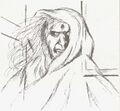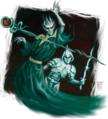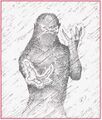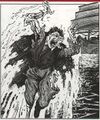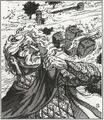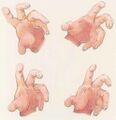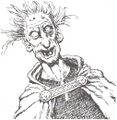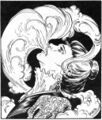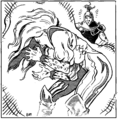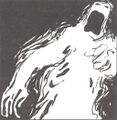Ghost

"Sir, what you have there is what we refer to as a focused, non-terminal repeating phantasm, or a Class Five full roaming vapor. Real nasty one, too!"
- – Ghostbusters
A Ghost (also known as spooks, specters, and phantoms; known erroneously as geists, ghouls, phantasms, or spooky bois), is the restless spirit of a deceased humanoid (or, rarely, animal) that returns from the grave to haunt the world of the living. The reason why varies immensely from ghost to ghost; common individual reasons include a need to achieve some task they failed in life, making amends for wrongs they committed, seeing to the protection of something or someone dear to them, pursuing vengeance, or simply failing to realize they are actually dead.
The standard form of a ghost is a pale, translucent figure, often seemingly obscured by mist or blurry, even when observed at conversational ranges. Ghosts are often cloaked in robes or sheets, reminiscent of depictions of angels in loose togas, but more eerie. By the 20th Century the stereotypical ghost had evolved into a see-though figure cloaked entirely in a sheet. They were capable of walking through walls and other solid objects, and their presence often made the immediate area unusually cold. They could be antagonistic or helpful, ranging from bad omens, deceased loved ones coming back to check on their still-living family to vengeful spirits with legitimate grievances against their killers. This depiction is a classic horror monster, and sets itself apart from the more Christianity-centric depictions of the spirits of the deceased which had come before in popular Western culture.
More modern depictions of ghosts are closer to ethereal monsters, having malleable or stretchy features and being capable of appearing and disappearing at will. These very recent depictions of ghosts follow more closely to the malevolent poltergeist depiction, acting maliciously, guarding locations, and performing jump-scares on unknowing victims. This may be due more to modern horror trends than the definition of "ghost" evolving to fit the times.
You most likely know all of this already. Why did you even come to this article?
General Biology and Weakness in various depiction[edit | edit source]
Spiritualists theorized that ghosts were made out of a spiritual substance called Ectoplasm (In greek Ecto means "outside", and plasma means "something formed or molded"). This idea was never accept by science, but is widespread in pop culture.
Ghost are generally unharmed by any physical means (arrow, swords, bullets). In certain depiction they can be harmed by flame. To truly able to damage them, any kinds of magical enchanted weapon is needed. In a more modern science fiction setting, psychic power from a person can harm them with their power.
To combat ghost without magic or psychic power, there are scientists in some modern setting that combats them with some sort of electrical devices that shoots lightning. Most notably in Ghostbusters, a nuclear powered device called particle accelerator system (or Proton Pack) is used to create a charged particle beam that can restrain ghosts (also known as negatively charged ectoplasmic entities in the movie setting).
Ghost often roam in the wild at night, and will have to avoid burnt to a crisp by hiding in abandon houses or caves when the sun comes up. Some ghost prefer to stay beside their dead body and were unable to passed on into the afterlife (unless the Grim Reaper (aka the personification of death) would come and manually claim their souls).
Dungeons & Dragons[edit | edit source]
The ghost has been part of D&D since the 1970s, with the ability to hit enemies with aging rather than energy-drain. Just seeing one might inflict 10 years and also cause the viewer to flee in terror. The ghost was a 10 HD undead, to be Turned above vampire-level at 9 HD. As a result - for the early 1980s - the ghost could be encountered only in AD&D campaigns. In that other early-'80s branch, Tom Moldvay's, the ghost was too powerful for Basic and Expert play. Jean Wells in 1981 tried nerfing one for B3: Palace of the Silver Princess (turned as a wight); but you know how THAT worked out.
-
1e
-
2e
-
3e
-
4e
-
5e
-
Pathfinder
Variants[edit | edit source]
The lore had stuck Frank Mentzer with the problem of how to detail, and to assign, an undead even more powerful than the vampire. It wasn't about the HD, since Expert play allowed all manner of 10 HD beasties - it was all the other special abilities. Mentzer eventually buffed up the ghost enough for the "Haunt" subtype, Companion Set; and he took away the Fear effect, relocating that to the weaker "Phantom" subtype. Ghosts were the only undead as weren't all Chaotic (=evil). Note that the "Haunt" appears between Gargantua and Gremlin (also out of order); likely is that "Ghost" was at first the subset with "Banshee", "Poltergeist" and perhaps "Haunt" as the genera within it.
Ghost variants, subtypes and synonyms include:
- Aquatic Remnant: The ghosts of people whose remains were thrown into bodies of water after they died. Their touch drains Dexterity. Just called Remnants when they originally appeared in RQ2: Thoughts of Darkness.
- Arayashka: The ghosts of people who froze to death. Their touch drains Strength.
- Banshee: Though considered a type of fey in mythology, in D&D, banshees are the ghosts of female elves.
- Bowlyn: The ghosts of sailors who died at sea.
- Bussengeist: The ghosts of those who died in great disasters or tragedies caused by their own hand. They are drawn to sites of future disasters, warning others of the coming catastrophe. They don't have any attacks, instead having an aura of despair that gives all Good creatures -4 to all rolls.
- Druj: Ghosts that can only possess small body parts, like hands, skulls, or eyes. They can split themselves into four identical copies. They are also poisonous.
- Geist: A ghost NPC that can't attack. Remade into a template in 3e for a ghost with unique powers.
- Ghostly Horde: A whole army of ghosts from the losing side of a battle.
- Gossamer: Ghosts that both drain Constitution and regenerate hitpoints with each attack. They are part of the Saugh, the undead army of the Shadow Fey.
- Haunt: They cannot be turned at all, and will relentlessly attempt to possess the nearest available humanoid and then make them strangle themselves.
- Odem: Ghosts specializing in possession.
- Odic: Ghosts that can only possess plants. Anyone coming within 20 feet of them must save or lose a level every round.
- Phantom: Phantoms are not enemies but silent spiritual images perpetually re-enacting a traumatic death, like a looping hologram. They still cause the same Fear save as a ghost, though.
- Poltergeist: Poltergeists attack by throwing random objects, but none of their attacks can actually deal any damage. Instead, anyone hit by an attack makes a Fear save.
- Psionic Spirit: Ghosts that bend spoons with their mind.
- Rushlight: The ghost of an evil person who was burned alive. They have fire powers because their soul has merged with the flames or whatever.
- Spectral Hag: The ghost of a hag.
- Spectral Scion: From Birthright. The ghost of a scion who was killed and bloodthefted with a tighmaevril weapon.
- Spectral Wizard: The ghost of a spellcaster.
- Spectre: Basically just a more powerful Wraith.
- Valpurgeist (renamed Valpurleiche in 3e): The ghost of someone who was hanged for a crime they did not commit. Poetically, it kills its victims by strangulation.
- Zhentarim Spirit: The ghost of a Zhentarim wizard. Introduced in the Ruins of Zhentil Keep boxed set.
Pathfinder[edit | edit source]
2e[edit | edit source]
An archetype that any class can take.
Ghost Women, and Lust Therefore[edit | edit source]

Yeah, that figures. Not that we're judging.
Strangely, ghosts are the most likely of the undead to get the Monstergirls treatment, perhaps because it's easy to get away with just portraying them as attractive human women who happen to have unusual abilities, like walking through walls or flying. This is aided by the fact that there are many, many stories in real life folklore and mythology of women becoming ghosts out of love in some fashion, including the "ghost girl who wants to find love despite being undead". Ghostly romance stories are surprisingly in vogue over on /a/.

